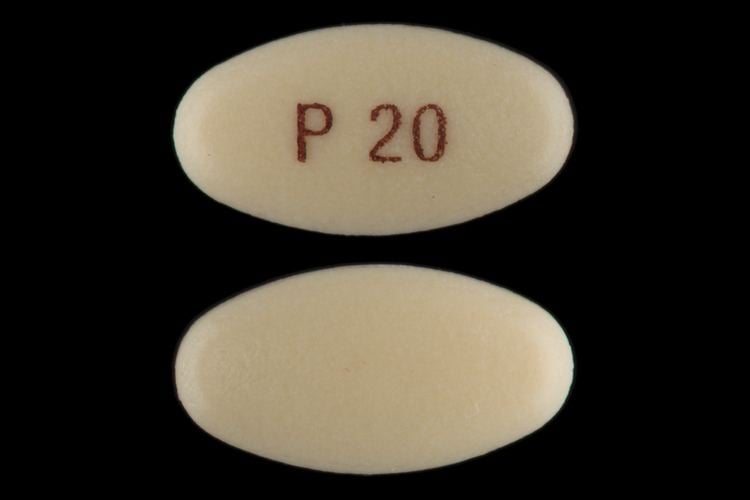AHFS/Drugs.com Monograph License data US FDA: Pantoprazole Bioavailability 77% | MedlinePlus a601246 Molar mass 383.371 g/mol CAS ID 102625-70-7 | |
 | ||
Trade names originally Protonix, subsequently many others Pregnancycategory AU: B3US: B (No risk in non-human studies) Routes ofadministration By mouth and intravenous | ||
Heart minute pantoprazole lacks clopidogrel interaction
Pantoprazole, first sold under the brand name Protonix, is used for short-term treatment of erosive esophagitis associated with gastroesophageal reflux disease (GERD), maintenance of healing of erosive esophagitis, and pathological hypersecretory conditions including Zollinger–Ellison syndrome.
Contents
- Heart minute pantoprazole lacks clopidogrel interaction
- Medical uses
- Pregnancy
- Breast feeding
- Children
- Elderly
- Adverse effects
- Common
- Rare
- Long term use
- Interactions
- Pharmacology
- History
- Society and culture
- References
Some common side effects of pantoprazole use in adults include: headache, diarrhea, nausea, abdominal pain, vomiting, flatulence, dizziness, and joint pain (>2%). Use of pantoprazole for a long period of time may lead to chronic inflammation of stomach lining or atrophic gastritis, vitamin B-12 deficiency, and low magnesium.
Pantoprazole is a proton pump inhibitor drug that inhibits gastric acid secretion. It works on gastric parietal cells to irreversibly inhibit (H+/K+)-ATPase function and suppress the production of gastric acid. It was first sold in 1994 in Germany and became avaliable as a generic medication in 2010.
Medical uses
Pantoprazole is used for short-term treatment of erosion and ulceration of the esophagus for adults and pediatric patients 5 years of age and older caused by gastroesophageal reflux disease. It can be used as a maintenance therapy for long-term use after initial response is obtained, but there have not been any controlled studies about the use of pantoprazole past a duration of 12 months. Pantoprazole may also be used in combination with antibiotics to treat ulcers caused by Helicobacter pylori. It can also be used for long-term treatment of Zollinger-Ellison syndrome.
Pregnancy
U.S.A Pregnancy Category B: In reproductive studies using doses largely greater than the recommended doses performed on rats and rabbits, there was no evident harm on the development of the baby.
Breast feeding
Pantoprazole has been found to pass through the breast milk. However, in rodent cancer studies, pantoprazole has been shown to potentially cause tumor growth. The clinical relevance of the finding is unknown, but risks and benefits are recommended for consideration in determining the use of therapy for the mother and child.
Children
Pantoprazole is only indicated for the short-term treatment of erosive esophagitis in children ages 5 and older; and the safety and effectiveness of pantoprazole have only been established in the treatment of erosive esophagitis in children.
Elderly
The incidence of adverse effects occurring in patients aged 65 years and older were similar to those in patients aged 65 years and less.
Adverse effects
Common
Rare
Long-term use
Interactions
Pharmacology
The mechanism of action of pantoprazole is to inhibit the final step in gastric acid production. In the gastric parietal cell of the stomach, pantoprazole covalently binds to the H+/K+ ATP pump to inhibit gastric acid and basal acid secretion. The covalent binding prevents acid secretion of up to 24 hours and longer.
Pantoprazole is metabolized in the liver by the cytochrome P450 system. Metabolism mainly consists of demethylation by CYP2C19 followed by sulfation. Another metabolic pathway is oxidation by CYP3A4. Pantoprazole metabolites are not thought to have any pharmacological significance. It is usually given with a prokinetic drug because of inactivity in the acidic environment of the stomach. Pantoprazole binds irreversibly to H+K+ATPase (proton pumps) to suppress the secretion of acid. Due to irreversible binding of the pumps, new pumps have to be made before acid production can be resumed. The drug's plasma half-life is about 2 hours.
History
Pantoprazole was discovered by scientists at Byk Gulden, a subsidiary of Altana; the drug discovery program started in 1980 and produced pantoprazole in 1985 - the compound was actually created by chemists working on scaleup of a different chemical that had been chosen as a development candidate. Byk Gulden partnered with Smith Kline & French in 1984. The compound's development names were BY1029 and SK&F96022. By 1986 the companies had created the sodium salt, pantoprazole sodium sesquihydrate, and determined to develop that as it was more soluble and stable, and was more compatible with excipients used in formulation. It was first marketed in Germany in 1994. Wyeth licensed the US patent from Altana. and obtained marketing approval from the US FDA in 2000 under the trade name Protonix.
In 2004 worldwide sales of the drug were $3.65 billion, about half of which were in the US.
In 2007 Altana's drug business was acquired by Nycomed. Nycomed was in turn acquired by Takeda in 2011 and Wyeth was acquired by Pfizer in 2009.
The patent protecting the drug was set to expire in 2010, but Teva Pharmaceutical filed an ANDA in 2007, and Wyeth and Nycomed sued Teva for patent infringement, but Teva decided to launch its generic drug "at risk" that year, before the patent had been invalidated. Wyeth launched an authorized generic in 2008. Pfizer and Takeda's patent exclusivity expired in 2010, and an administrative exclusivity they had for pediatric use expired in January 2011, and full generic competition began. The litigation between Teva and Pfizer/Takeda was settled in 2013, with Teva paying the patent holders $2.15 billion in damages for its early launch.
Society and culture
As of 2017, was marketed under many brands worldwide, including as a combination drug with domperidone, a combination with itopride, in combination with both clarithromycin and amoxicillin, in combination with levosulpiride, and in combination with naproxen.
